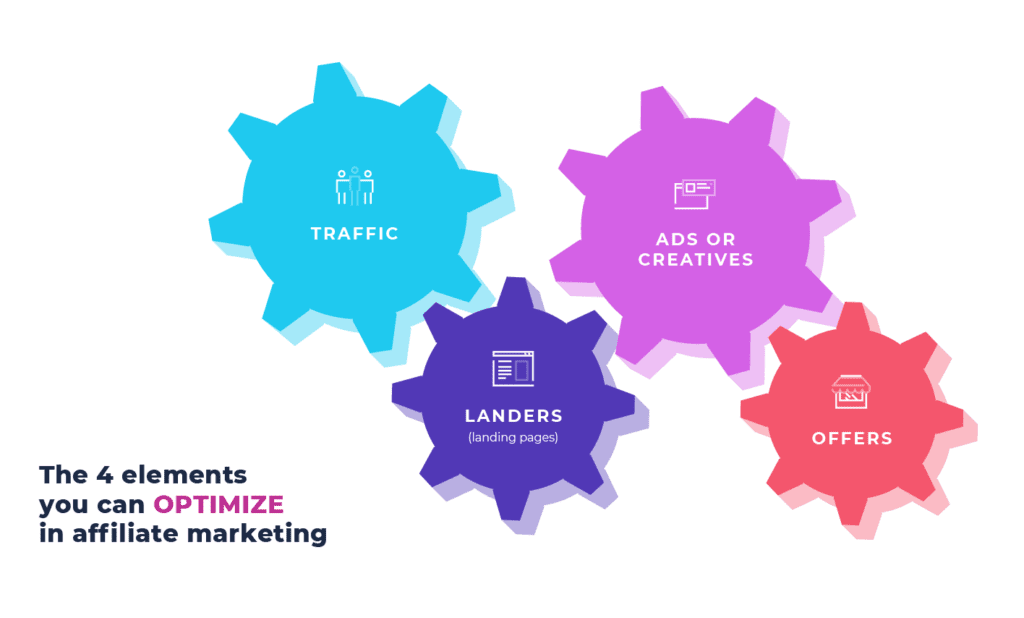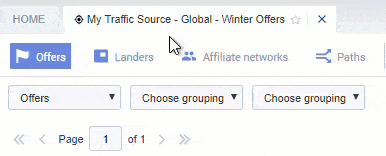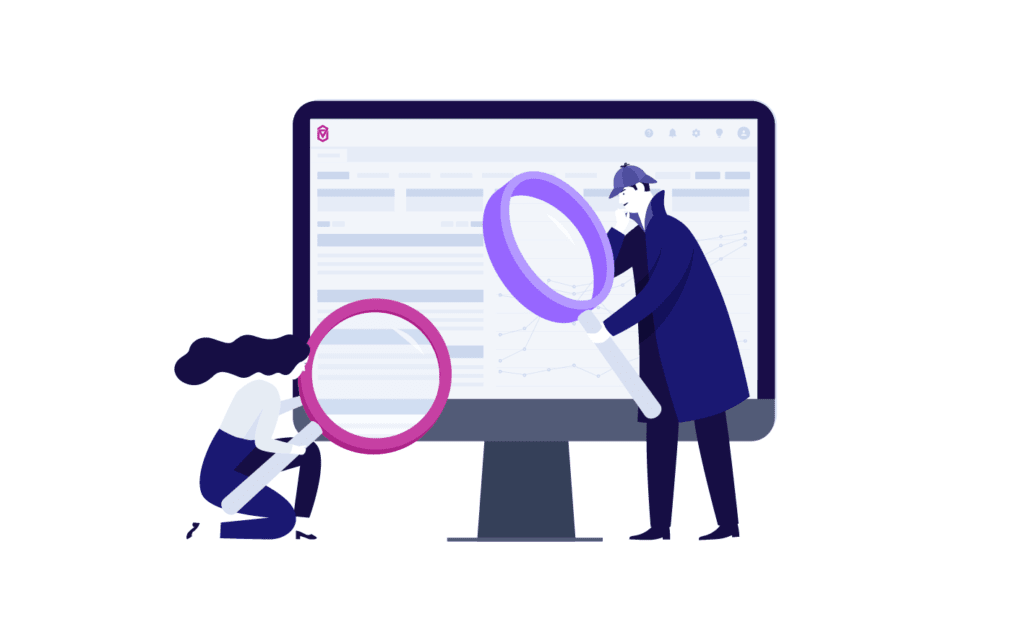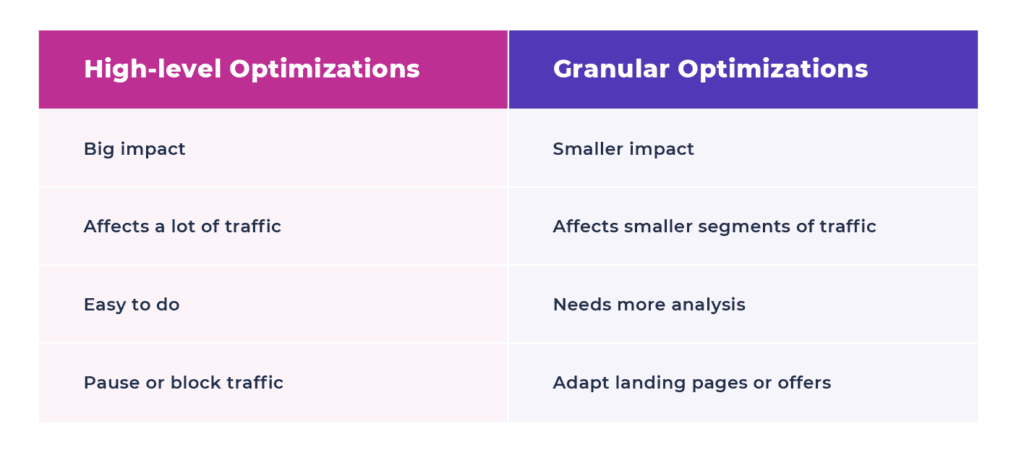When you start tracking in performance marketing, all that data can be very overwhelming. It’s hard to know what it all means and what you should focus on. But that data is the key to making money online and affiliate marketing campaign optimization.
Without data that you can understand and analyze, it’s pure luck if you generate a profit or not. And you certainly won’t be able to increase your return on your ad spend.
So we have prepared a step-by-step affiliate marketing tutorial to help newbies understand their reports and know what data they should look at when they start a campaign and once you have even more data.
The 4 Parts of Your Campaigns You Can Optimize
There are four aspects that you can optimize in your affiliate marketing campaigns.
- Traffic
- Ads or creatives (some traffic doesn’t have ads like domain redirects)
- Landers or Landing pages (these are optional but useful)
- Offers
The magic is finding a good match between all four.
The right traffic sees the right ad, which sends them to the right lander and ends with conversions from the right offer. If one part is wrong, the whole stack can fall.

Each aspect could have many books written on their best practices so this tutorial will take a different approach. It presents a procedure for effective affiliate campaign optimization that will help you avoid basic mistakes. You’ll learn how to use your tracking data and reports that Voluum provides to find out what is work and what isn’t.
This procedure isn’t the only way to go about campaign optimization, but it is an effective approach for new affiliates to adopt. Before we start I need to tell you a couple of ugly truths.
- You will have to spend some money and may not see a return for a while
- Some campaigns can’t be optimized. The traffic and offer just won’t match no matter what.
With that in mind, it’s time to get started. The sooner you start, the sooner you can start making a profit.
Step 1: Prepare Before You Launch
Before the traffic starts flowing, you need to make sure you prepare properly. After all…
Failure to plan is planning to fail
Benjamin Franklin
If you kick a campaign off without proper planning, you’ll always be reactive. Instead, you should prepare properly so you can have a plan of action ready. This means actions including
- Evaluating and reviewing offers from affiliate networks.
- Recording the criteria for different offers (If you can only run it in one geo or for certain traffic types).
- Checking ad placements from different traffic sources (where possible).
- Finding out what ad types suit the offer vertical you want to run.
- Investigating if this type of offer works best as direct linking or with landing pages.
- Getting inspiration from other advertising campaigns.
Getting data like this will help you set up better campaigns from the start, avoid stupid mistakes and have a clear plan for what you can optimize and work on.
Step 2: Check Your Traffic Source Options
The easiest campaign optimizations are on the traffic sources side but not all traffic sources offer the same options. For example, some traffic sources let you buy traffic based on device type (desktop/mobile/tablet) and OS (Android/iOS) so you can pause traffic that isn’t converting from one of these options. Other networks might have different options or limits such as only provide mobile traffic.
You also want to make sure you have your custom variables set up in your traffic sources so you get all the data that they can send you. For example, some native traffic sources can pass on the type of placement the traffic comes from (for example, editorial news, men’s health, gaming), this is data Voluum can’t collect without setting it up on the traffic source side.
Pro Tip: Set up Useful Bookmarks in Your Reports
If your traffic source can pause or block certain types of traffic then create a report for that data and create a bookmark for later. That way, it’s ready for you to access and will show you exactly the comparison that matters in this campaign.

For example, a pop campaign running on mobile and desktop. Depending on your traffic source, you may be able to pause traffic based on whether it is coming from mobile or desktop as well as the network connection. If you create a bookmark for a drill down report comparing first mobile and desktop data and then network connections, you’ll be able to quickly access this data whenever you log in or use the mobile app.
Step 3: Make Sure Your Traffic Is Flowing Properly
At this point, you should make sure that you aren’t just throwing your money away for no reason. Testing your campaign setup will make sure that traffic goes from your traffic through to your landing page (called a lander in Voluum) and ultimately, offer.
Check out our documentation Testing Guide to learn how.
Step 4: Wait Till You Have Statistically Significant Data
No one is dumb enough to think that if the first visitor converts that means every visitor will convert. However, many affiliates make poor campaign optimization decision as they are too hasty. The see a pattern start to emerge and take action, but sometimes they need to wait longer.
Your first set of visitors may have more visitors who respond well to your advert.
You need to make sure that you have enough data to be certain of your conclusion.
And that’s where statistical significance comes in.
This old school math principle is a fundamental of statistics and performance marketing. Here’s the basic summary of it. If you have a little data which is all very different, that is low-significance, if you have a lot of data that is all closely grouped together, that’s high-significance. (This really is a dummies definition and isn’t completely accurate but I don’t want to bore you with P values and Null hypothesis).
In performance marketing, that means that if you have two sets of data, let’s say desktop and mobile, each with over a thousand hits and desktop has a 20% conversion rate, but mobile only has a 1% conversion rate, you’ve got a significant trend that you should take action on.
But if you only had 20 hits, and the difference is 20% and 19% CTR, then it’s not a statistically significant difference yet and you shouldn’t send more traffic.
You can use this simple calculator to check if you have got statistically significant data or the optimization calculator built into Voluum.
Step 5: Check If Your Campaign is Bad
There’s a chance that you’ve got a bad offer or your lander just doesn’t work. This is the time to check and make sure that you aren’t trying to fix something that’s fundamentally flawed. If you aren’t getting any conversions then there could be a few causes.
- You haven’t set your campaign up correctly (check the error log).
- The offer doesn’t apply to this traffic (for example, the wrong geo or device type).
- Your lander just isn’t convincing (check the click-through rate and read our guide on landing page optimization).
- The offer just isn’t appealing (look at the conversion rate).
You can try to avoid some of these issues by running multiple landers and offers, but that means you need to buy more traffic to get significant data and you will need to adopt a slightly different process.

This is due to the possibility that some offers and landers may work for certain parts of your traffic, while others may work for other parts.
If you start looking at the general performance of a lander or offer, you may assume that this element simply doesn’t work, but it may just have poor performance for certain traffic.
An example is a lander that works well for mobile traffic but doesn’t for desktop. If you get more desktop traffic, it will seem like it is less effective than it really is.
If you are running one offer or lander and notice that they just aren’t working, it’s time to start over.
Step 6: Apply High-level Campaign Optimizations
Let’s assume that you have got some useful data and there’s potential, it’s time to find those easy optimizations which have the most significant impact. From step two, you should have a list of action points based on your traffic source’s options.
If your traffic source lets you select and pause mobile or desktop traffic, that’s an easy optimization. If the traffic source lets you pause certain sources, then that’s another easy optimization.
It’s difficult to say what these high-level actions will be exactly as traffic source options differ a lot. That’s why you should have checked them in step 2. You want to cut the worst performing options straight away. So traffic with around 20% CTR on your lander is an okay sign, whereas 3% is unlikely to be profitable.
Some typical campaign optimizations at this point include
- Device type (desktop/mobile/tablet)
- OS (Windows/Mac/Android/IOS)
- Connection type (Celular/Wifi/Ethernet)
Note: If you are running multiple offers or landers, it is worth checking each option against these high-level options. Let’s continue with the mobile and desktop example. You may notice that one lander works better with mobile and another with desktop traffic. If these will both bring in a profit, you can then set up a rule-based path to direct mobile traffic to the lander which is working with mobile traffic, and desktop traffic to the other one.
If, however, one option is better but still not profitable, it’s better to pause the traffic.
Step 7: Carry Out Granular Campaign Optimizations
After taking care of the high-level optimizations, it’s time to dive into the details and work on getting the most out of your campaigns. It’s not worth starting at granular campaign optimization as
- You will be optimizing smaller amounts of traffic meaning it will have less effect
- You will probably improve performance less than higher-level optimization
- It usually takes more time to perform these optimizations
Some of these optimizations include
- Different OS versions
- Different Browser
- Different ISPs
- Different connection types
At this point, you can’t pause this traffic so you have one option left. Use rule-based paths to redirect this traffic to a better lander, offer or a combination of the two.

You may notice that this traffic has no hope in hell of being profitable, if that’s the case, why not experiment? You can always try and increase your click-through rates and conversion rates even if the click-through rates just aren’t going to work.
You have to pay for the traffic, so you might as well test some of the design, coding or copywriting that you can then use for profitable traffic later.
Some of These Campaign Optimizations Can Be Done for You
Certain traffic sources provide tools to assist you with optimization. For example, they may have rules that let you pause certain elements if they don’t bring in enough conversions within a certain time range. Some traffic sources have options like eCPA which start to pause traffic sources which aren’t converting.
These can save you time from carrying out high-level campaign optimizations.
Voluum also offers Traffic Distribution AI for Basic and higher plans, this lets you test run traffic to multiple offers, landers or paths and adjusts the weighting of that traffic based on your evaluative criteria.
Start your Affiliate Campaign Optimization
Now you know a simple campaign optimization procedure it’s time to put this affiliate marketing tutorial into action. If you already have a Voluum account, you can log in now and get started. If you are looking to get started in affiliate marketing, sign up for our new Entry plan. It gives you the core functions that you need to run an affiliate marketing campaign.
When you’ve got an account
- Identify a good offer from inside Voluum thanks to our new Marketplace feature
- Do some research on the offer and what traffic will best suit it.
- Set up your core campaign elements. (you can read how in our documentation)
- Start the traffic flowing and wait till you have enough data
- Start with high-level campaign optimizations
- Squeeze every last penny with more granular options.





One comment
“But if you only had 20 hits, and the difference is 20% and 19% CTR, then it’s not a statistically significant difference yet and you shouldn’t send more traffic.”
You mean you SHOULD send more clicks, right?